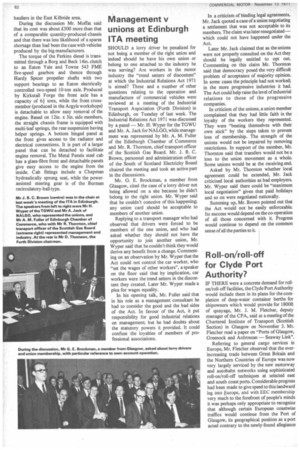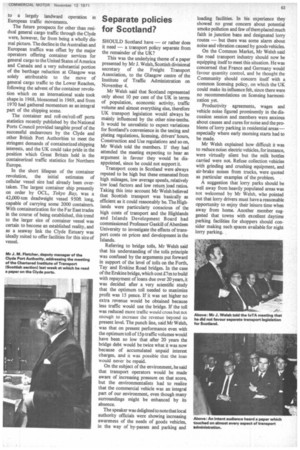Roll-on/roll-off for Clyde Port Authority?
Page 64

Page 65

If you've noticed an error in this article please click here to report it so we can fix it.
IF THERE were a concrete demand for rollon/roll-off facilities, the Clyde Port Authority would include them in its plans for the completion of deep-water container berths for shipowners which would provide for 1800ft of quayage, Mr. J. M. Fletcher, deputy manager of the CPA, said at a meeting of the Chartered Institute of Transport (Scottish Section) in Glasgow on November 3. Mr. Fletcher read a paper on "Ports of Glasgow, Greenock and Ardrossan — Seaway Link".
Referring to general cargo services in Europe, Mr. Fletcher observed that the everincreasing trade between Great Britain and the Northern Countries of Europe was now very largely serviced by the new motorway and autobahn networks using sophisticated roll-on/roll-oft techniques at selected east and south coast ports. Considerable progress had been made to give speed to this landward leg into Europe, and with EEC membership very much to the forefront of people's minds it was perhaps only appropriate to recognize that although certain European coastwise traffics would continue from the Port of Glasgow, its geographical position as a port acted contrary to the newly-found allegiance to a largely landward operation in European traffic movements.
The future prospects for other than resi dual general cargo traffic through the Clyde were, however, far from being a wholly dis mal picture. The decline in the Australian and European traffics was offset by the major operators offering container services for general cargo to the United States of America and Canada and a very substantial portion of the berthage reduction at Glasgow was solely attributable to the move of general cargo traffic to the Lower Reaches, following the advent of the container revolu tion which on an international scale took shape in 1968, blossomed in 1969, and from 1970 had gathered momentum as an integral part of the shipping scene.
The container and roll-on/roll-off ports statistics recently published by the National Ports Council provided tangible proof of the successful endeavours by the Clyde and other British Port Authorities to meet the stringent demands of containerized shipping interests, and the UK could take pride in the position which Great Britain held in the containerized traffic statistics for Northern Europe.
In the short lifespan of the container revolution, the initial estimates of cellular vessel size had already been over
taken. The largest container ship presently on order by OCL, Tokyo Bay, was a
42,000-ton deadweight vessel 950ft long, capable of carrying some 2000 containers. With containerization for the Far East trades in the course of being established, this trend to the larger size of container vessel was certain to become an established reality, and as a seaway link the Clyde Estuary was ideally suited to offer facilities for this size of vessel.










































































































































































































